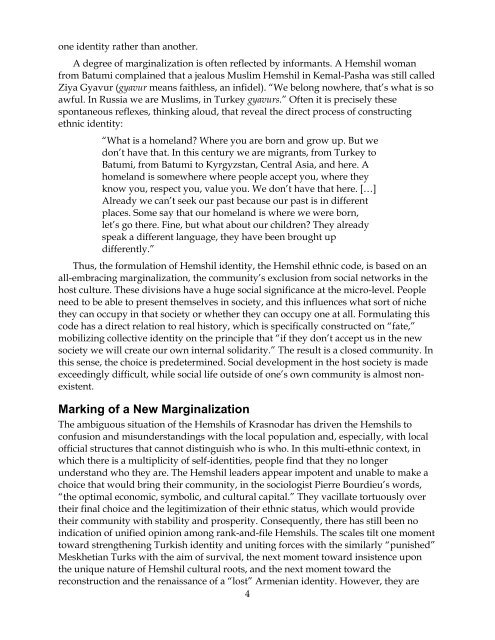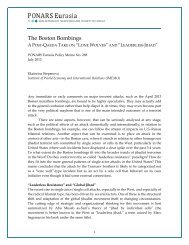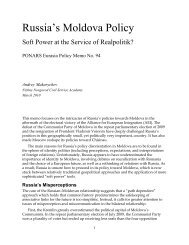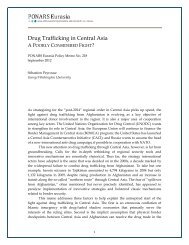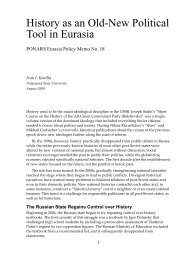HEMSHIN, HOMSHETSI, OR HEMSHINLI? - PONARS Eurasia
HEMSHIN, HOMSHETSI, OR HEMSHINLI? - PONARS Eurasia
HEMSHIN, HOMSHETSI, OR HEMSHINLI? - PONARS Eurasia
- No tags were found...
You also want an ePaper? Increase the reach of your titles
YUMPU automatically turns print PDFs into web optimized ePapers that Google loves.
one identity rather than another.A degree of marginalization is often reflected by informants. A Hemshil womanfrom Batumi complained that a jealous Muslim Hemshil in Kemal-Pasha was still calledZiya Gyavur (gyavur means faithless, an infidel). “We belong nowhere, that’s what is soawful. In Russia we are Muslims, in Turkey gyavurs.” Often it is precisely thesespontaneous reflexes, thinking aloud, that reveal the direct process of constructingethnic identity:“What is a homeland? Where you are born and grow up. But wedon’t have that. In this century we are migrants, from Turkey toBatumi, from Batumi to Kyrgyzstan, Central Asia, and here. Ahomeland is somewhere where people accept you, where theyknow you, respect you, value you. We don’t have that here. […]Already we can’t seek our past because our past is in differentplaces. Some say that our homeland is where we were born,let’s go there. Fine, but what about our children? They alreadyspeak a different language, they have been brought updifferently.”Thus, the formulation of Hemshil identity, the Hemshil ethnic code, is based on anall-embracing marginalization, the community’s exclusion from social networks in thehost culture. These divisions have a huge social significance at the micro-level. Peopleneed to be able to present themselves in society, and this influences what sort of nichethey can occupy in that society or whether they can occupy one at all. Formulating thiscode has a direct relation to real history, which is specifically constructed on “fate,”mobilizing collective identity on the principle that “if they don’t accept us in the newsociety we will create our own internal solidarity.” The result is a closed community. Inthis sense, the choice is predetermined. Social development in the host society is madeexceedingly difficult, while social life outside of one’s own community is almost nonexistent.Marking of a New MarginalizationThe ambiguous situation of the Hemshils of Krasnodar has driven the Hemshils toconfusion and misunderstandings with the local population and, especially, with localofficial structures that cannot distinguish who is who. In this multi-ethnic context, inwhich there is a multiplicity of self-identities, people find that they no longerunderstand who they are. The Hemshil leaders appear impotent and unable to make achoice that would bring their community, in the sociologist Pierre Bourdieu’s words,“the optimal economic, symbolic, and cultural capital.” They vacillate tortuously overtheir final choice and the legitimization of their ethnic status, which would providetheir community with stability and prosperity. Consequently, there has still been noindication of unified opinion among rank-and-file Hemshils. The scales tilt one momenttoward strengthening Turkish identity and uniting forces with the similarly “punished”Meskhetian Turks with the aim of survival, the next moment toward insistence uponthe unique nature of Hemshil cultural roots, and the next moment toward thereconstruction and the renaissance of a “lost” Armenian identity. However, they are4


